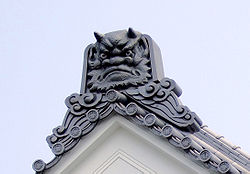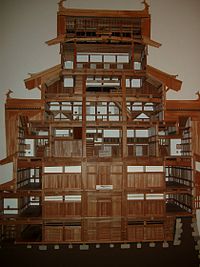- Onigawara
-
Onigawara (鬼瓦 lit. ogre tile) are a type of roof ornamentation found in Japanese architecture. They are generally roof tiles or statues depicting a Japanese ogre (oni) or a fearsome beast. Prior to the Heian period, similar ornaments with floral and plant designs (hanagawara) preceded the onigawara.[1] The present design is thought to have come from a previous architectural element, the oni-ta, which is a board painted with the face of an oni and was meant to stop roof leaks. During the Nara period the tile was decorated with other motives, but later it acquired distinct ogre-like features and became strongly tridimensional.[2] Onigawara are most often found on Buddhist temples. The tile's name notwithstanding, the ogre's face may be missing.
Contents
Images
See also
- Shibi (roof tile)
- Shachihoko
- Gargoyle
- Chimera (architecture)
- Imperial roof decoration
- Japanese architecture
Notes
- ^ "onigawara 鬼瓦." JAANUS. Retrieved on June 12, 2009.
- ^ DeAgostini Kodera/Butsuzō DVD series, Hōryū-ji issue's pamphlet
References
- Parent, Mary Neighbour. (2003). Japanese Architecture and Art Net Users System.
External links
Elements of Japanese architecture Styles Buddhist · Buke · Daibutsuyō · Gassho · Giyōfū · Hachiman · Hirairi · Hiyoshi (also called Hie) · Irimoya · Ishi-no-ma · Kasuga · Kibitsu · Nagare · Ōbaku Zen · Setchūyō · Shinden · Shinmei · Shinto · Shoin · Sukiya · Sumiyoshi · Taisha · Wayō · ZenshūyōA model of Himeji Castle
Building types Roof styles Structural Burdock piling · Chigi · Disordered piling · Engawa · Fusuma · Hisashi · Irimoya-zukuri · Irori · Jinmaku · Katōmado · Katsuogi · Kuruwa · Mokoshi · Moya · Nakazonae · Namako wall · Nightingale floor · Onigawara · Ranma · Shōji (see also washi) · Sōrin · Tamagaki · Tatami · Tokonoma · Tokyō · Tsumairi · ShibiGates and approaches Rooms Furnishings Outdoor objects Measurements Groups See also Buddhist temples in Japan Japanese Buddhist architecture Architectonic elements Mon (gates) Buildings Chinjusha · chōzuya/temizuya · -dō · main hall (kon-dō, hon-dō, butsuden) · kuri · kyōzō or kyō-dō · shoinTō or Buttō (pagodas) Styles Others A-un · kenSchools and objects of worship Major schools Zen schools Nanto rokushū Objects of worship Amida Nyōrai · Benzaiten · Dainichi Nyorai · Jizō · Kannon · Marishi-ten · Shaka Nyorai · Shitennō (Four Kings) · Twelve Heavenly Generals (Jūni Shinshō) · Yakushi NyoraiOther elements Implements kei (ritual gong) · mokugyōOthers bussokuseki · butsudan · Glossary of Japanese Buddhism · Japanese Buddhist pantheon · jingū-ji · miyadera · saisenbakoCategories:- Japanese architecture
- Japanese architectural features
- Japanese building and structure stubs
Wikimedia Foundation. 2010.






